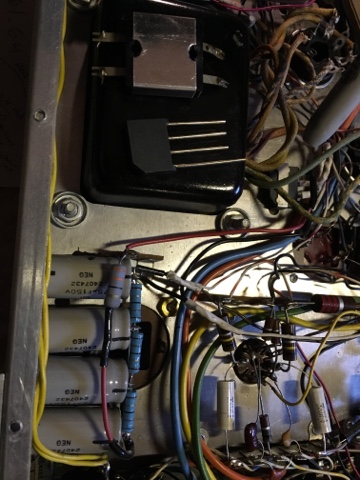In this late fall season there is a battle,
a consistent yet finite barrage of falling leaves.
The ground crew is hindered
by the suffocated grass they try to protect,
as the ground is too soft for faster but heavier equipment.
Ruts are bad.
Here the tools of choice are backpack blowers,
rakes,
and possibly these gas powered side blowers.
Funny thing is all three were broken.
Bad head gasket on #1,
bad exhaust manifold/muffler on #2,
and a coil on #3.
The coil was easy,
I just swapped one from the bad head gasket donor.
The guys were all over it,
justifying the fix of the other two.
The replacement exhaust manifold had a screw on outlet,
but nothing to screw in.
I raided the scrap pile for tubes and pipe fittings,
and welded up a custom muffler.
All that practice with hot rods, boats,
motorized bikes and scooters...
The new silencer worked perfectly,
quieter than most of our engine tools here.
other than the mini front roller digging into the soft grass.
No problem.
Some quick brackets and a fat roller wheel...
Zip zip with a welder and voila!
Now get out of here and start blowing leaves...
There are acres of leaves...
To pick them up.
there's a Toro Rake-O-Vac,
basically a trailer vacuum/rake,
that hadn't worked in a couple years.
New battery,
an overpriced coil,
and this was good to go.
It works great on unpiled leaves.
Well...
One of the guys pulled a full load to the compost area,
hit a whoop-de-doo in the road,
that opened up the trap door,
spilling a compacted pile that took 2 hours to clean.
Now nobody wants to use it!
Then they dug up this thing,
a stadium vacuum,
previously attached to a broken buggy.
It worked great til the hose broke for the umpteenth time.
The fallback is the good old pitchfork.
Manual labor at its finest.
Scoop by scoop...
the leaves slowly disappear.
Until one of the trucks takes a chit.
A busted starter allowed the fix of a lingering oil leak,
probably the rear main seal.
This meant tearing out the transmission,
fun on a 4x4 with a transfer case.
Years ago work had traded a local junkyard a broken vehicle,
for this ford ranger which had a bad transmission,
along with a replacement.
The previous mechanics got it running,
but cranked every bolt so tight they were barely able to unthread.
The exhaust wouldn't come off without breaking a bolt.
To make room I cut and hammered the welded seam lip,
visible on the top there.
While I did technical stuff
like cut out a hard to find gasket...
The outside guys laid around.
It wasn't much fun putting this together,
but there was success getting it running.
Time for something fun.
I found a scrap bumper in a metal pile.
It was set aside for this truck,
but nobody could cut and weld here.
Some crude bracketry...
Cut cut Zip zip...
Now we could push gates open,
and move trash cans around.
Didn't take long to get it back to work.
Seriously there are tons of leaves here.
They'll get composted into the mulch pile,
and eventually returned back to the earth.
I still need to get the 3rd blower working,
too late for this season.
At least everything is green again!
TP





























































